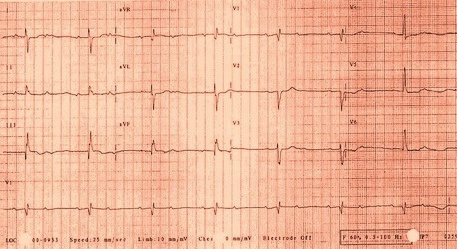Rheumatic fever electrocardiogram: Difference between revisions
Jump to navigation
Jump to search
No edit summary |
No edit summary |
||
| Line 1: | Line 1: | ||
__NOTOC__ | __NOTOC__ | ||
{{Rheumatic fever}} | {{Rheumatic fever}} | ||
{{CMG}}; {{AE}} [[Varun Kumar, M.B.B.S.]] | {{CMG}}; {{AE}} [[Varun Kumar, M.B.B.S.]]; {{AG}} | ||
==Overview== | ==Overview== | ||
On electrocardiogram, rheumatic fever is characterized by PR prolongation, [[Heart block|conduction abnormalities]], [[arryhthmias]] or [[P mitrale]] depending on the structures involved and the extent of cardiac damage. | |||
==Electrocardiogram== | ==Electrocardiogram== | ||
ECG changes depend on the structures involved and the extent of cardiac damage. | ECG changes depend on the structures involved and the extent of cardiac damage. The following ECG changes may be noted in patients with rhumatic fever:<ref name="pmid20294585">{{cite journal| author=SOKOLOW M| title=The electrocardiogram in the diagnosis and management of rheumatic fever. | journal=Calif Med | year= 1947 | volume= 66 | issue= 4 | pages= 221-6 | pmid=20294585 | doi= | pmc= | url= }} </ref> | ||
*Sinus [[tachycardia]] or [[bradycardia]] depending on vagal tone | *Sinus [[tachycardia]] or [[bradycardia]] depending on vagal tone | ||
*Prolongation of [[PR interval]] may be noted in some patients | *Prolongation of [[PR interval]] may be noted in some patients | ||
*Variable degree of AV conduction block | *Variable degree of AV conduction block | ||
[[File:2to1AVBlock1.jpg|thumb|500px|left|2 to 1 AV block]] | [[File:2to1AVBlock1.jpg|thumb|500px|left|2 to 1 AV block]] | ||
<br clear="left"/> | <br clear="left"/> | ||
| Line 19: | Line 19: | ||
<br clear="left"/> | <br clear="left"/> | ||
*Mital valve abnormalities may lead to development of [[atrial flutter]] or [[atrial fibrillation]] | *Mital valve abnormalities which may lead to development of [[atrial flutter]] or [[atrial fibrillation]] | ||
*[[T-wave]] inversions | *[[T-wave]] inversions which may be noted in leads I, II and IV suggestive of [[pericardial]] involvement | ||
*[[ST segment elevation]] may also be present in leads II, III, aVF and V<sub>4</sub> to V<sub>6</sub> in patients with acute [[pericarditis]] | *[[ST segment elevation]] may also be present in leads II, III, aVF and V<sub>4</sub> to V<sub>6</sub> in patients with acute [[pericarditis]] | ||
==References== | ==References== | ||
Revision as of 17:49, 19 October 2015
|
Rheumatic fever Microchapters |
|
Diagnosis |
|---|
|
Treatment |
|
Case Studies |
|
Rheumatic fever electrocardiogram On the Web |
|
American Roentgen Ray Society Images of Rheumatic fever electrocardiogram |
|
Risk calculators and risk factors for Rheumatic fever electrocardiogram |
Editor-In-Chief: C. Michael Gibson, M.S., M.D. [1]; Associate Editor(s)-in-Chief: Varun Kumar, M.B.B.S.; Anthony Gallo, B.S. [2]
Overview
On electrocardiogram, rheumatic fever is characterized by PR prolongation, conduction abnormalities, arryhthmias or P mitrale depending on the structures involved and the extent of cardiac damage.
Electrocardiogram
ECG changes depend on the structures involved and the extent of cardiac damage. The following ECG changes may be noted in patients with rhumatic fever:[1]
- Sinus tachycardia or bradycardia depending on vagal tone
- Prolongation of PR interval may be noted in some patients
- Variable degree of AV conduction block

- P mitrale may be noted, which is suggestive of left atrial enlargement secondary to mitral valve abnormalities.

- Mital valve abnormalities which may lead to development of atrial flutter or atrial fibrillation
- T-wave inversions which may be noted in leads I, II and IV suggestive of pericardial involvement
- ST segment elevation may also be present in leads II, III, aVF and V4 to V6 in patients with acute pericarditis
References
- ↑ SOKOLOW M (1947). "The electrocardiogram in the diagnosis and management of rheumatic fever". Calif Med. 66 (4): 221–6. PMID 20294585.
- ↑ Image courtesy of ECGPedia (2015). http://en.ecgpedia.org/wiki/Short_coupled_Torsades_de_Pointes Accessed on October 19, 2015.